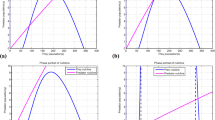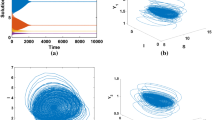Abstract
A mathematical model of two predators hunting on a single type of prey is constructed in this study. We also include the fact that the two predator species fight for food and shelter both within and between species. Prey confronts biomass loss in predator–prey interactions, which is well documented, but predators also face the risk of contracting an infection from prey, which is less well investigated. We have thus taken this into consideration in this paper. The two predators’ predation functions are assumed to be the same and follow the Holling Type-I functional response. All ecologically possible equilibrium points are found analytically and numerically. Stability and bifurcation analyses are performed thereafter. The analytical conclusions are demonstrated and validated through the use of numerical simulations.
Access this chapter
Tax calculation will be finalised at checkout
Purchases are for personal use only
Similar content being viewed by others
References
Lotka AJ (1925) Elements of physical biology. Williams and Wilkins
Volterra V (1927) Variazioni e fluttuazioni nel numero di individui in specie animali conviventi. Memorie del Regio Comitato Talassografico Italiano mem. CXXXI (ripubb. in V. Volterra, Opere matematiche. Memorie e note, voi. V, Roma, Ac cademia Nazionale dei Lincei, 1962); Kostitsin VA (1938) Rémarques sur l’action toxique du milieu. Comptes Rendus, Académie des Sciences, p 207
Mukhopadhyay B, Bhattacharyya R (2016) Effects of harvesting and predator interference in a model of two-predators competing for a single prey. Appl Math Model 40(4):3264–3274. https://doi.org/10.1016/j.apm.2015.10.018
Kar TK, Ghorai A, Jana S (2013) Dynamic consequences of prey refugia in a two-predator-one-prey system. J Biol Syst 21(02):1350013. https://doi.org/10.1142/S0218339013500137
Savitri D, Suryanto A, Kusumawinahyu WM (2019) A dynamics behaviour of two predators and one prey interaction with competition between predators. In: IOP conference series: materials science and engineering. IOP Publishing, vol 546, no 5, p 052069. https://doi.org/10.1088/1757-899X/546/5/052069
Savitri D, Suryanto A, Kusumawinahyu WM (2020) Dynamical behavior of a modified Leslie-Gower one prey-two predators with competition. Mathematics 8(5):669. https://doi.org/10.3390/math8050669
Llibre J, Xiao D (2014) Global dynamics of a lotka-volterra model with two predators competing for one prey. SIAM J Appl Math 74(2):434–453. https://doi.org/10.1137/130923907
Jana A, Roy SK (2021) Behavioural analysis of two prey-two predator model. Ecol Complex 47:100942. https://doi.org/10.1016/j.ecocom.2021.100942
Sarwardi S, Mandal PK, Ray S (2013) Dynamical behaviour of a two-predator model with prey refuge. J Biol Phys 39(4):701–722. https://doi.org/10.1007/s10867-013-9327-7
Didiharyono D (2016) Stability analysis of one prey two predator model with Holling type III functional response and harvesting. J Math Sci 1(2):50–54
Beddington JR (1975) Mutual interference between parasites or predators and its effect on searching efficiency. J Anim Ecol 331–340
DeAngelis DL, Goldstein RA, O’Neill RV (1975) A model for tropic interaction. Ecology 56(4):881–892. https://doi.org/10.2307/1936298
Crowley PH, Martin EK (1989) Functional responses and interference within and between year classes of a dragonfly population. J North Am Benthol Soc 8(3):211–221. https://doi.org/10.2307/1467324
Arditi R, Ginzburg LR (1989) Coupling in predator-prey dynamics: ratio-dependence. J Theor Biol 139(3):311–326. https://doi.org/10.1016/S0022-5193(89)80211-5
Hassell MP, Varley GC (1969) New inductive population model for insect parasites and its bearing on biological control. Nature 223(5211):1133–1137
Hsu SB (1982) On a resource based ecological competition model with interference. J Math Biol 12(1):45–52. https://doi.org/10.1007/BF00275202
Dubey B, Upadhyay RK (2004) Persistence and extinction of one-prey and two-predators system. Nonl Anal Model Control 9(4):307–329. https://doi.org/10.15388/NA.2004.9.4.15147
Wang Z, Xie Y, Lu J, Li Y (2019) Stability and bifurcation of a delayed generalized fractional-order prey-predator model with interspecific competition. Appl Math Comput 347:360–369. https://doi.org/10.1016/j.amc.2018.11.016
Manna K, Volpert V, Banerjee M (2020) Dynamics of a diffusive two-prey-one-predator model with nonlocal intra-specific competition for both the prey species. Mathematics 8(1):101. https://doi.org/10.3390/math8010101
Ali N, Haque M, Venturino E, Chakravarty S (2017) Dynamics of a three species ratio-dependent food chain model with intra-specific competition within the top predator. Comput Biol Med 85:63–74. https://doi.org/10.1016/j.compbiomed.2017.04.007
Fleischer SR, Bolnick DI, Schreiber SJ (2021) Sick of eating: eco-evo-immuno dynamics of predators and their trophically acquired parasites. Evolution 75(11):2842–2856. https://doi.org/10.1111/evo.14353
Perko L (2013) Differential equations and dynamical systems. Springer Science & Business Media, vol 7
Dhooge A, Govaerts W, Kuznetsov YA, Meijer HGE, Sautois B (2008) New features of the software MatCont for bifurcation analysis of dynamical systems. Math Comput Model Dyn Syst 14(2):147–175. https://doi.org/10.1080/13873950701742754
Marzal A, Lope FD, Navarro C, Møller AP (2005) Malarial parasites decrease reproductive success: an experimental study in a passerine bird. Oecologia 142(4):541–545. https://doi.org/10.1007/s00442-004-1757-2
Author information
Authors and Affiliations
Corresponding author
Editor information
Editors and Affiliations
Rights and permissions
Copyright information
© 2024 The Author(s), under exclusive license to Springer Nature Singapore Pte Ltd.
About this paper
Cite this paper
Das, D., Bhattacharjee, D. (2024). A Study on the Dynamical Behaviour of a Two Predator-One Prey Model Incorporating a Non-infectious Disease in Prey. In: Tavares, J.M.R.S., Rodrigues, J.J.P.C., Misra, D., Bhattacherjee, D. (eds) Data Science and Communication. ICTDsC 2023. Studies in Autonomic, Data-driven and Industrial Computing. Springer, Singapore. https://doi.org/10.1007/978-981-99-5435-3_27
Download citation
DOI: https://doi.org/10.1007/978-981-99-5435-3_27
Published:
Publisher Name: Springer, Singapore
Print ISBN: 978-981-99-5434-6
Online ISBN: 978-981-99-5435-3
eBook Packages: Intelligent Technologies and RoboticsIntelligent Technologies and Robotics (R0)




